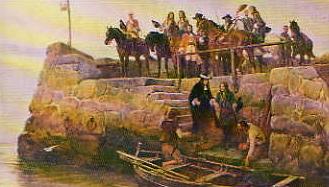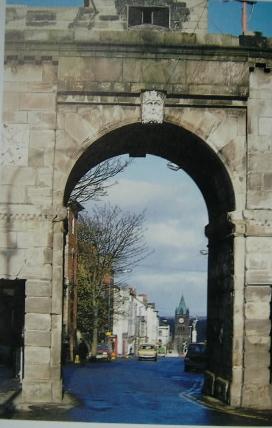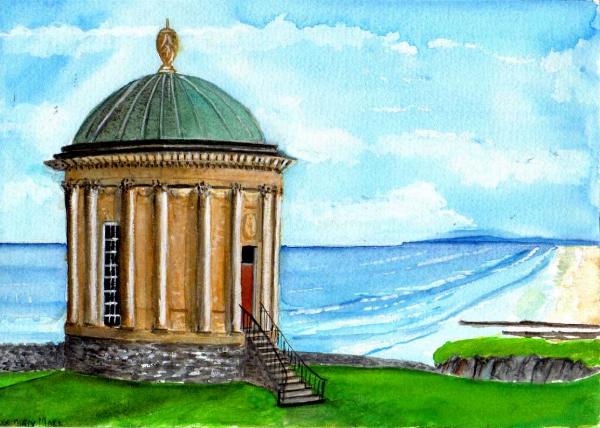History of County Derry.Samuel Lewis' History of Derry City. |
| |
|
The
city of Derry is said to have been The Vikings raided Derry in 783 and 812 in the latter case the monks and students were slaughtered. Samuel Lewis writes, "The place must have been speedily restored, as, in 832, the Danes were driven with great slaughter from the siege of Derry by Niall Caille, King of Ireland, and Murchadh, Prince of Aileach In 983, the shrine of St. Columbkill was carried away by the Danes, by whom the place was also thrice devastated about the close of the 10th century: in 1095 the abbey was consumed by fire". During the twelfth and thirteenth centuries the Mac Lochlainn clan ruled the settlement, this was a period of prosperity and growth, many prestigious new buildings were erected, and the monastery and school associated with it thrived. With the decline of the Mac Lochlainn's Derry too began to lose its importance. The arrival of the Normans in the late 1100's saw the building of a fortress by the de Burgos, at Greencastle near the the entrance to Lough Foyle. In the second half of the sixteenth century Queen Elizabeth I's aim was to conquer Ulster which was the only part of Ireland outside English control. A garrison was established at Derry in 1566 but it only lasted a few years. In 1600 during the 'Nine Years War' another garrison was established which proved more successful. When the war ended in 1603 the town was given the status of City and a trading settlement was established. All went well until 1608 when the city was attacked and almost wiped out by Sir Cahir O'Doherty. O'Doherty had previously supported the English cause. |
|||
|
This attack came about shortly after the 'flight of the earls' (1607) when the O'Neill and O'Donnell chieftains, together with their principal supporters, set sail from Lough Swilly for the continent, leaving Gaelic Ulster leaderless. James I of England acceded to the throne in 1603 he decided on a revolutionary plan to subordinate Ulster. After the flight of the Earls, England confiscated their lands. The City of London Companies a group of rich merchants were granted all the lands between the Foyle and the Bann rivers. They undertook to build up the towns of Coleraine and Derry, renaming it Londonderry and to spend 20,000 pounds in developing their grant. Derry / Londonderry was enclosed by massive stone and earthen fortifications, it is one of the few towns in Ireland which retains its original street layout, it was the last walled city to be built in Ireland and is the only one to retain its walls almost intact. Among the city's new buildings was St. Columb's Cathedral built in 1633. This is one of the most important seventeenth century buildings in the country and was the first post Reformation Protestant cathedral erected in these islands. |
||||
|
|
||||
The
Siege of Derry. |
||
| Derry
became Londonderry by royal charter The city in the 1680's had a population of 2,000 the largest in Ulster, yet it was slow to prosper suffering as did the rest of the country, during the rebellion of 1641 which lasted for ten years. James II's accession to the English throne in 1685 raised hopes in the Irish Catholics that he would allow them to recover their lands. In 1688, the English people deposed James and offered the throne to William of Orange, a Dutch prince who was married to James daughter Mary. James fled to France, returning in the following year, to Ireland with French support, in the hope that the Roman Catholics there would help him to recover his throne. The Protestants proclaimed their allegiance to King William III and fortified the towns of Londonderry and Enniskillen James arrived at the gates of Derry on April 18 1689, and called on the city to surrender. His invitation was declined and actually fired at by some of the more determined defenders. The Jacobite forces outside the city settled in to Siege the city into submission. This siege was to last for 105 days. James's artillery rained cannonballs and mortar-bombs on the city, as time progressed the inhabitants suffered appalling conditions, as famine and disease took its toll. Outside the walls conditions were little better, and many people died, both inside and outside the walls. Finally at the end of July, a relief ship The Mountjoy broke the barricading 'boom' which had been stretched across the river, near where the new Foyle Bridge now stands. The governor of Derry during the siege the Reverend
George Walker issued a price list for food within the city. |
||
|
|
 founded
in 546 AD by St Collumcill on land given to him by his cousin the Prince
of Aileach. The name comes from the Irish Doire, meaning oak grove. It
was in all possibility a place which was sacred to the pre Christian Gaelic
people. The saint said that 'the angels of God sang in the glades of Derry
and every leaf held its angel.'
founded
in 546 AD by St Collumcill on land given to him by his cousin the Prince
of Aileach. The name comes from the Irish Doire, meaning oak grove. It
was in all possibility a place which was sacred to the pre Christian Gaelic
people. The saint said that 'the angels of God sang in the glades of Derry
and every leaf held its angel.'  on the 29th March 1613. After '
on the 29th March 1613. After '